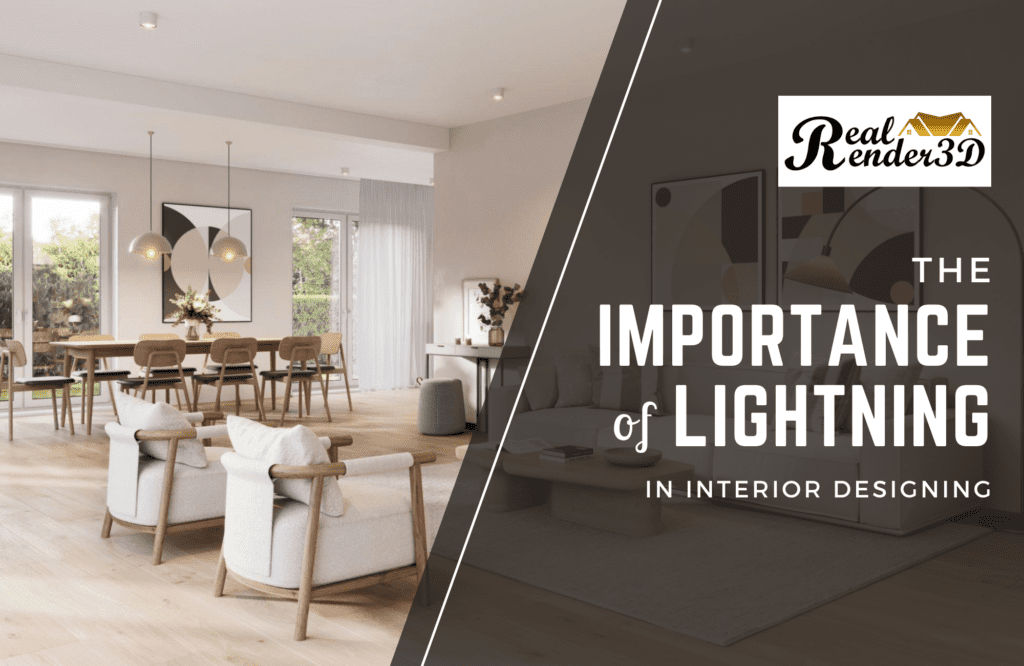The Importance of Lighting in Interior Design
Lighting is a crucial aspect of interior design, overlooked by many, but the secret to shaping our spaces. Proper lighting helps you enhance your space’s functionality, highlight focal points, and create ambiance. Grasp the fundamental elements and their implementation for a good lighting design. These include accent lighting, task lighting, and ambient lighting. Keep scrolling to learn the importance of lighting and how to transform your space into a magnificent, well-illuminated palace.
Set The Perfect Mood With Ambient Lighting
The ambient aspect is used for general lighting, giving your room a welcoming low and creating a soothing aura that engulfs every corner of your room, adding a sense of warmth. It would be best if you had pendant lights, flush mount lights, and more to achieve this. At the very least, consider investing in 3D visualization services, 3D interior rendering, virtual home staging, and 3D house design services.
Maximize Efficiency and Comfort With Task Lighting
It would help if you had task lighting for a shadow-free space when running errands in your residence. It meticulously illuminates every detail with clarity but does not add beauty to the mood of a room.
Showcase Your Treasured Decor With Accent Lighting
Accent lighting helps personalize your room and illuminate the walls while adding style and a touch of elegance. This can be achieved using toe kick lighting, artwork, track lights, cabinet, or shelf lighting. It needs experts for proper installation.
Type of Lighting
Natural Lighting
Natural lighting in interior design provides a vibrant and welcoming atmosphere by highlighting important architectural features and elevating ambience.
Artificial Lighting
Artificial lighting is manageable and easy to install. It highlights the space’s essential features, creating an appealing, welcoming environment.
How Lighting Choices Affects The Mood of a Room
Natural Lighting Can Create a Sense of Spaciousness and Openness.
Understand how the sunlight enters your rooms and its impact on the space. For instance, a living space with more openings will have more illumination giving it a sense of openness and spaciousness.
Artificial Lighting Can Be Used to Create a Variety of Moods and Atmospheres
Artificial lighting is integral for visual stimulation. Spending in brighter rooms is incredible, and artificial lighting plays a significant role in accentuating important aspects.
Tips To Guide You Choose The Correct Lighting For Your Space
Take into Account the Size and Shape of Your Space.
Correctly lighting your room makes it look accommodating and spacious. However, poorly lit rooms look cramped.
Think About the Activities That Will Take Place in the Room.
Understand the purpose of your room because every action has its unique lighting level to ascertain optimal mood, functionality, and visibility. For instance, accent activities need track lighting, while task-oriented activities need brighter illumination.
Choose Light Fixtures That Complement the Style of Your Décor.
Proper installation of lighting fixtures gives you an appealing look at the interior decoration of your space. For instance, office spaces rhyme with white lighting for productivity. Consider wall lighting to highlight important aspects. The interior design trends in 2023 will give you more hacks for creating a visually appealing room.
Enhance Your Home’s Appearance With These Lighting Tips
Use Task Lighting to Illuminate Specific Areas
Identify your space and determine whether it requires task lighting. Please select a suitable fixture that meets your desires, including floor lamps, and position it correctly, considering the light intensity.
Use Ambient Lighting to Create a General Light Level Throughout the Room.
Consider purpose, layout, and room size to determine your space’s appropriate ambient lighting fixtures. This is important for the even distribution of light throughout your commercial space and for determining favorable color temperature and light output for your room.
Use Accent Lighting to Highlight Architectural Features or Artwork.
You need a professional to identify the focal points correctly, get the right fixtures, position the lighting source at the right angle, and adequately configure color and light intensity.
Tips To Energy Efficient Lighting
Choose Energy-Efficient Light Bulbs.
Compact fluorescent and light-emitting diodes are energy-efficient light bulbs with a longer lifespan. The upfront charges are costly, but the energy consumption is low, saving much on your energy bills.
Install Dimmer Switches.
Dimmer switches give you greater control over energy consumption by allowing you to alter and modify the brightness of your lights.
Make Use of Natural Light
Make more use of natural light during the daytime by opening your room curtains to allow sunlight into your environment to save on cost.
Conclusion
In conclusion, light is integral in interior design. The importance of lighting is tremendous and includes drawing attention to your impressive space, creating an illusion of space and enhancing your room’s visual appeal and ambiance. Experience excellent interior design lighting and 3D rendering services from 3DRenderingWorld. We also have events for interior designers to attend in the UK 2023 to give you an in-depth understanding of interior design.
Frequently Asked Questions
What impact does light has on the perception of a room?
Utilizing light to create a larger, spacious, and welcoming room.
Name the common types of lighting in interior design.
These are accent lighting, task lighting, and ambient lighting.
What is the impact of lighting on the mood of an environment?
Bright and cool lighting gives you an energizing atmosphere, while soft and warm lighting gives you an intimate ambiance.
What are mistakes to avoid in interior design?
Avoid overreliance on artificial lighting, inconsistent colouring temperatures, and wrong placement fixtures.
How do I achieve energy efficiency in lighting design?
Use LED bulbs and natural lighting.
Alex Smith is a content writer at RealRender3D, writing informative articles on 3D rendering, interior design, architecture, and related topics.
With over 15 years of experience at top UK architecture and interior design firms, Alex leverages his expertise to write engaging content educating readers on AEC industry trends and best practices.
Connect with Alex at alex@realrender3d.co.uk.
